Football
Analysing India vs Kuwait: How Blue Tigers edged out Al-Azraq
As the referee blew the whistle for the final time on November 16, the Blue Tigers had secured their first FIFA World Cup qualifier win outside India in 22 years! Vying for a top two finish in a group of four teams over six games

Manvir Singh celebrates after scoring the winning goal against Kuwait as Nikhil Poojary looks on.
It was the third time India took on Kuwait in a span of four months, but this time around, it sparked a joyous celebration among the Indian fans, overseas and home.
As the referee blew the whistle for the final time at the Jaber Al-Ahmad International Stadium on November 16, the Blue Tigers had secured their first FIFA World Cup qualifier win outside India in 22 years! Vying for a top two finish in a group of four teams over six games; this win and the consequent addition of three points was crucial, and it set the tone right going into the big one against the Qataris.
Also Read | Here is how India can qualify for FIFA World Cup: Qualification scenarios
Both sides came in without their first choice squad as injury added to the selection trauma. India could not call up their dogged warhorses Jeakson Singh, Anwar Ali or Ashique Kuruniyan. All three of whom started in the recent two meetings between the two nations.
Likewise, Kuwait’s Portugese head coach Rui Bento could not call up his talismanic midfielder Ahmad Al Dhefiri who was also key in Al-Azraq’s run into the SAFF Finals earlier this year. With both teams having notable absentees, the game was bound to be different than before; in one way or another.
Igot Stimac’s starting line-up was one that caught eyes quickly. Proving earlier reports right, Stimac decided to start in a 4-2-3-1 formation, with Rahul Bheke at left center-back, Apuia and Suresh Singh forming the double pivot and Manvir being preferred to Lallianzuala Changtte on the right notably.
Kuwait went with a rather traditional 4-3-3, with their skipper Khalid Ibrahim at the heart of the defence, guarded by a midfield trio of Sultan Al Enezi (6), R. Abujabarah (14) and Athbi Saleh (18).
The Indian line-up itself was intriguing. Rahul Bheke — a right back by nature was playing as the left centre-back alongside Sandesh Jhingan. With India’s idea of build-up coming with CBs (centre-backs) splitting wide, allowing the full-backs to push up; there were questions regarding how Bheke would fare against the Kuwaiti attack while playing as a centre-back.
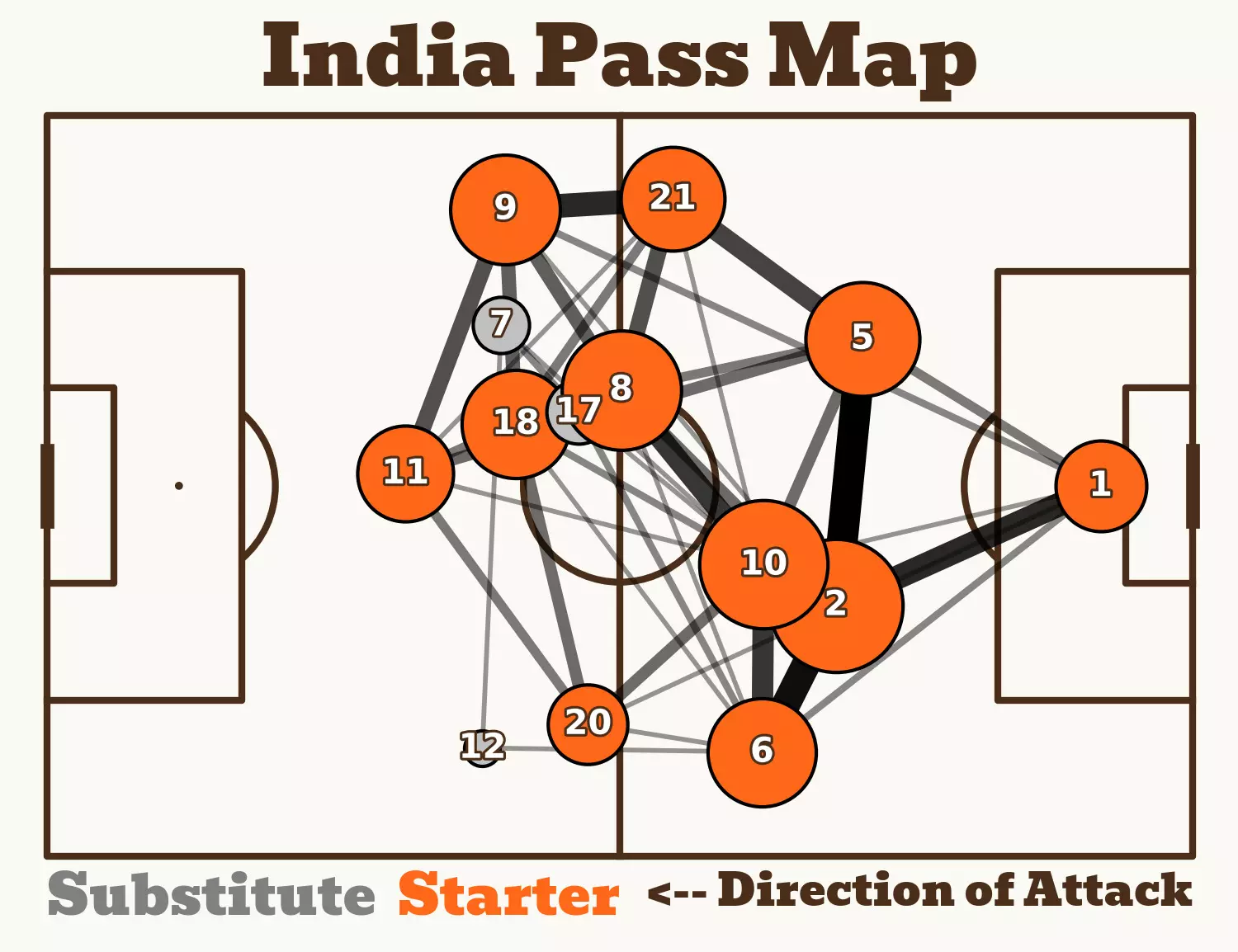
India in-possession played out a classic 4-2-3-1. The centre-backs split wide to allow the full-backs to push rather higher, alongside the pivots. Akash Mishra seemed to be much more offensive than Nikhil Poojary, constantly pushing up down his flank.
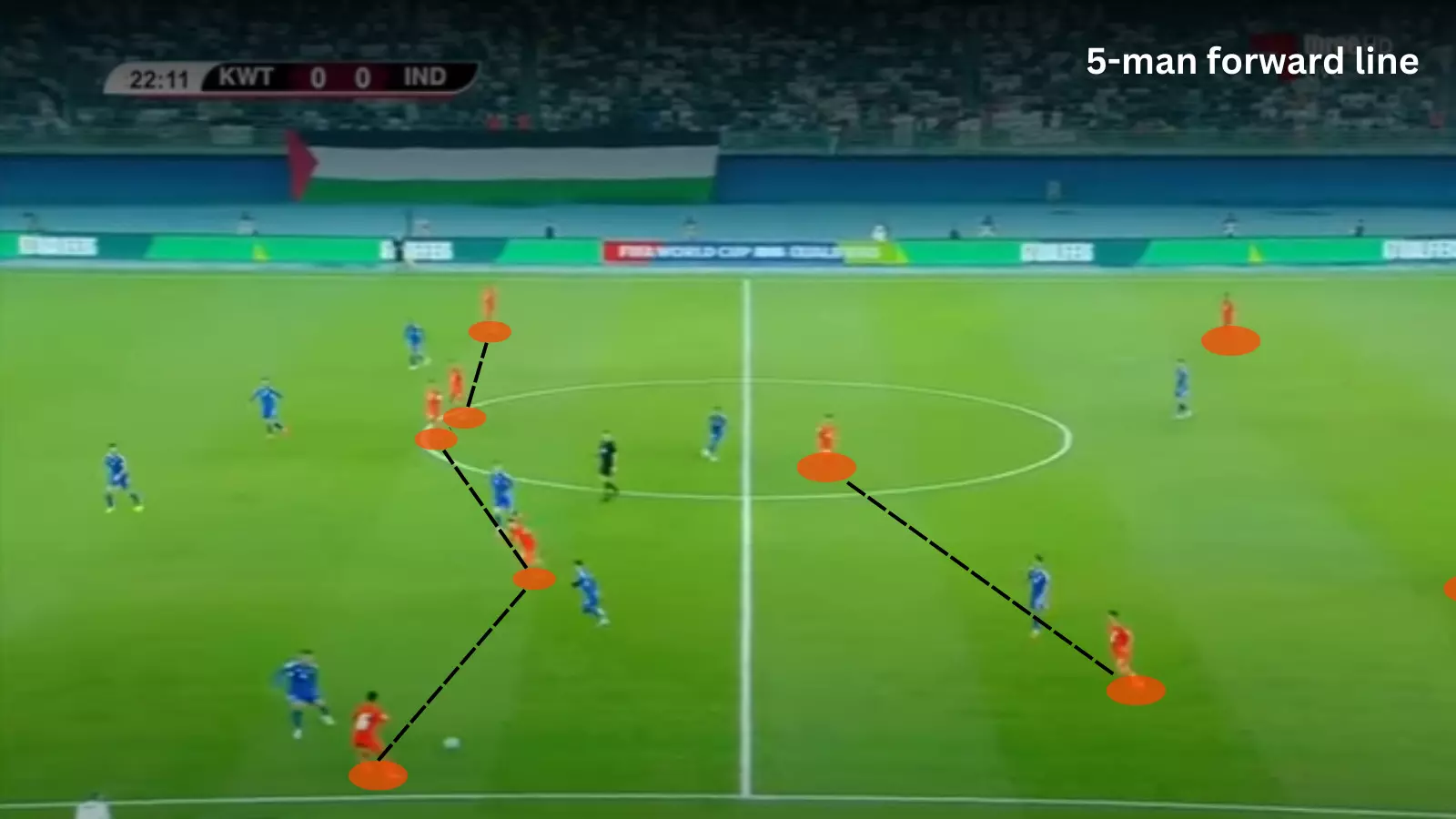
Mishra pushing up and occupying the wide left zones meant Naorem Mahesh could come in-field and play almost as an inside-forward. With Sunil Chhetri down the middle, Sahal in the #10 role and Manvir down the right; it created a 5 man frontline.
India often tried to facilitate creating sequences which would form the 5-man front line as said above. One of the common ways in which they worked at this was by using a pivot to fill in at full-back (left or right) to let that full-back join the offensive line. Apuia was brilliant in this role.
With Suresh usually holding, Apuia left to the wide slots letting either Akash Mishra or Nikhil Poojary to push on. Both Manvir and Mahesh are more adept as an inside forward than an outright winger, hence it played to their strengths.
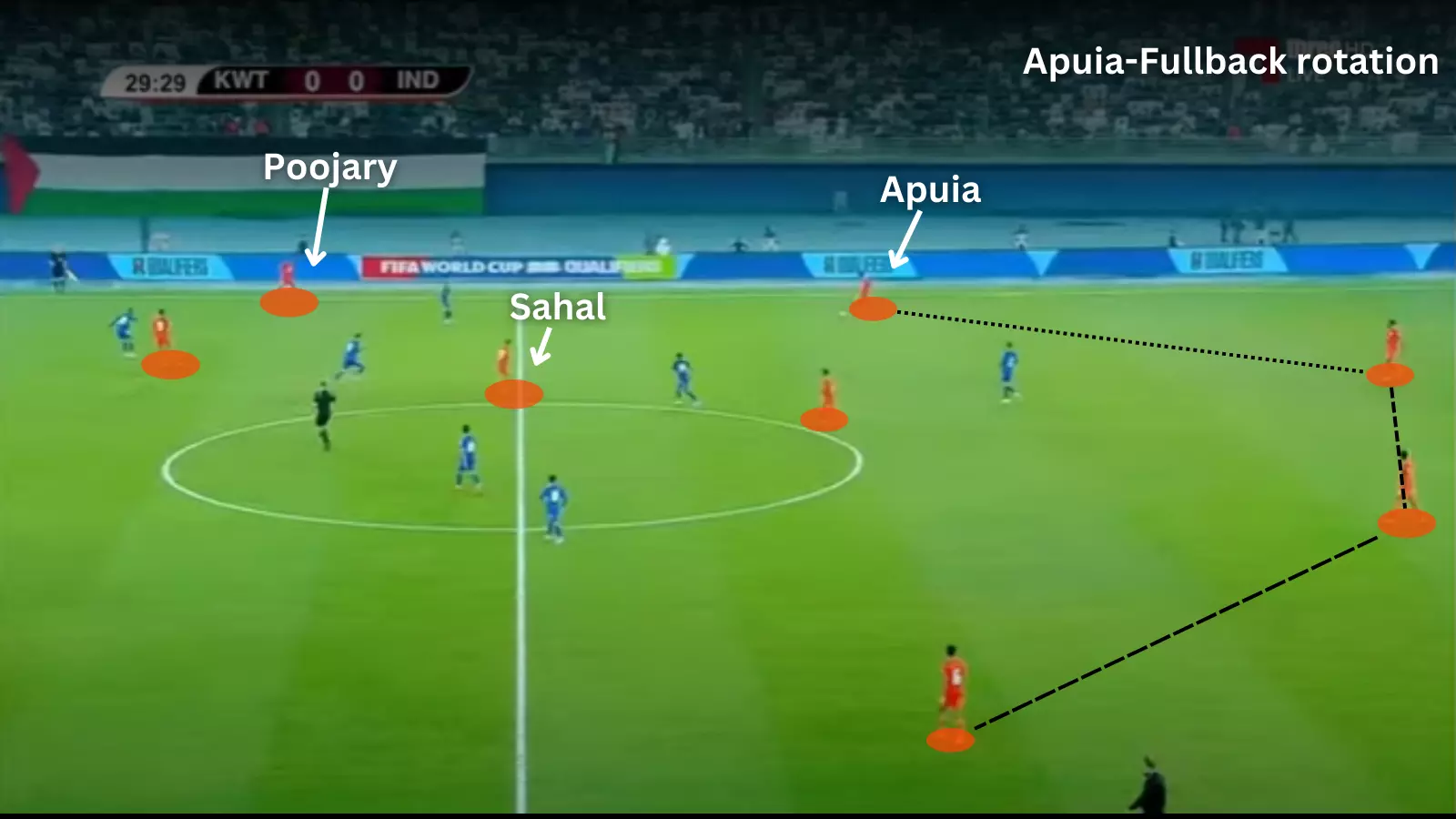
Out of possession, India pressed high whenever Kuwait’s build-up seemed a bit shaky. It was not a constant, high-pressing, high intensity game plan but rather a calculated, pertinent and instinctive set of pressing traps that functioned to certain identified triggers.
Kuwait could not help but play into the triggers as India were brilliant off the ball. With the midfield structures of both teams dynamically nullifying each other, Al-Azraq could not play out from the back as they hoped to, and India waited to pounce.
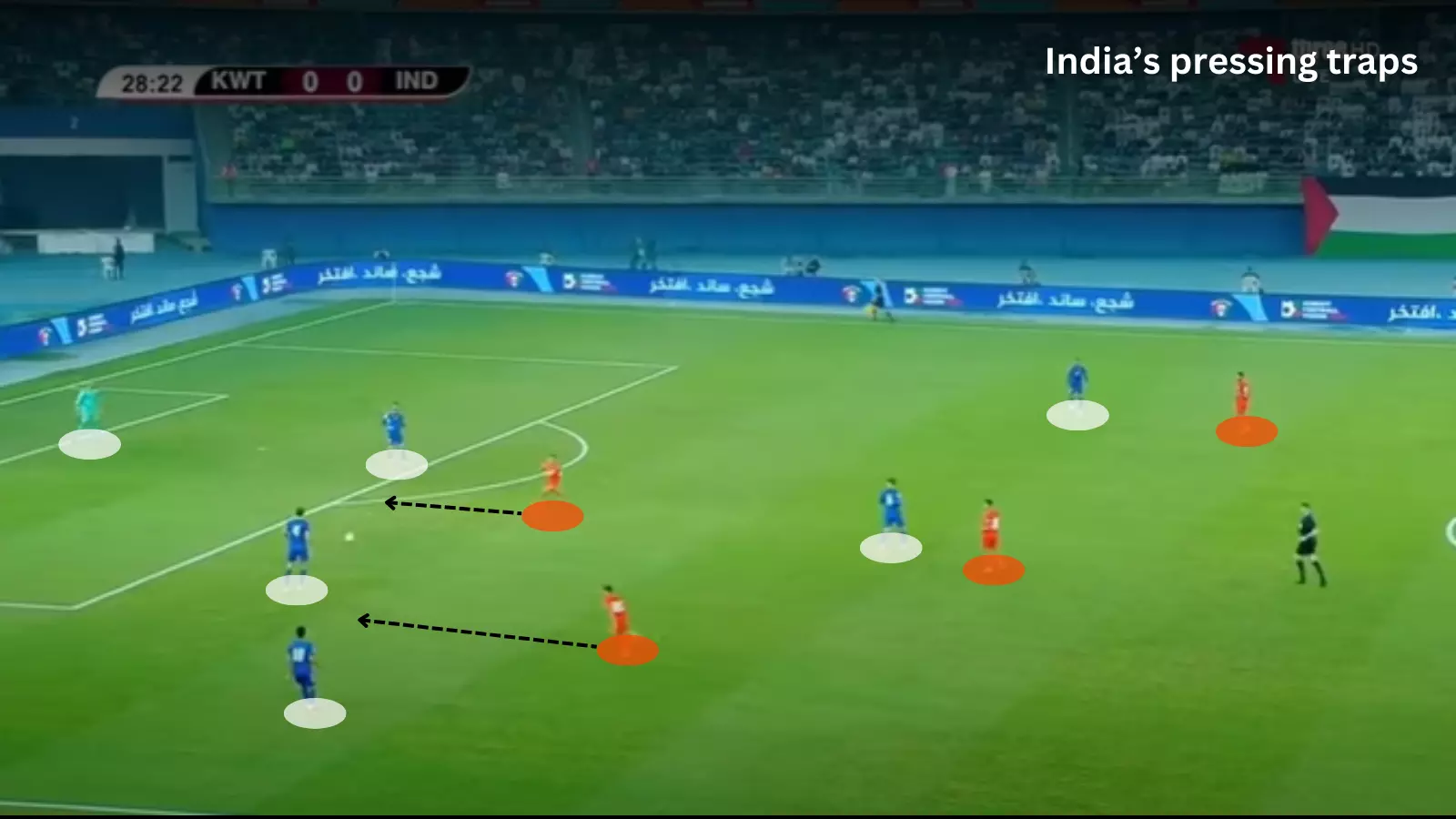
On one such instance (28th minute), a poor backward pass from Kuwait’s #6 (S. Al Enezi) to #2 (H. Al Enezi) acted as a trigger for India to hound for the ball. Led by Sunil Chhetri himself, followed by Naorem Mahesh; the duo quickly managed to cut out passing lanes to anyone else bar the keeper, who was also put under instant pressure by the Indian skipper, forcing A. Marzouq to clear the ball out of play to relieve pressure. Although nothing came of the move, it was a show of intent — a sign that India came to compete on the frontfoot.
Although, it was still a pretty even game on the whole, with both midfields nullifying each other, the game was stuck for both sides in build-up. Not having Al-Dhefiri meant Kuwait lacked that bit of flair to challenge the Indian backline more often. Without Anwar and Jeakson, India’s build-up seemed slower and less dynamic, denying either of the sides from building any real momentum in the game.
This is quite easily observable from in-game statistics as well. Both sides were great defensively as India managed to restrict the Kuwaitis to just one shot from inside the penalty area. Meanwhile, India themselves could only muster up two. None of the teams accumulated at least 0.5 xG (expected goals), with India managing just about 0.3 and Kuwait 0.2 xG over the game.
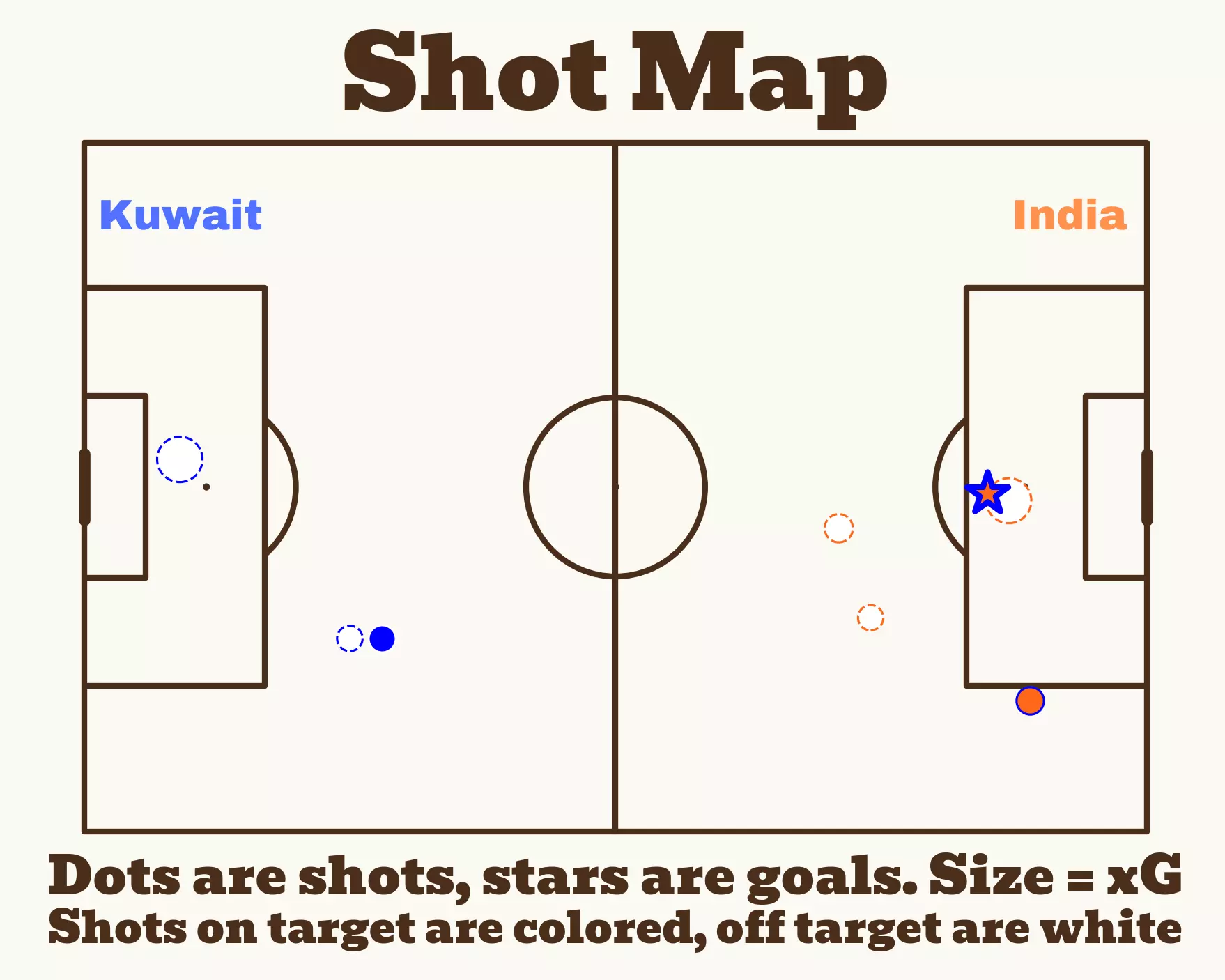
The difference point came in the form of a Manvir Singh goal in the 75th minute. But Manvir was given the opportunity by one of Stimac’s brilliant players — Lallianzuala Chhangte.
The Mizo winger posed as a question when the starting XI’s were released, but he turned out to be the answer that broke Kuwait. Tactically, Chhangte was a different profile for Kuwait to deal with compared to Mahesh.
He is more direct and explosive and not scared to run behind. Hence, with Chhangte running at pace in between the Kuwaiti right-back and right centre-back, Kuwait lost their footing for a split second and Manvir was there to pounce on the gem of a ball the Indian #17 laid on for him.
Arguably it was even a case of poetic justice. For the ‘show’ that Kuwait put on at every goal, even lucky ones when invited to India for the SAFF Championship; maybe the scriptwriters had it such that India had to score against Kuwait at their turf, beginning from a stop-start play which had India kick the ball out owing to fairplay due to an injured Kuwaiti player. Everything that goes around, comes around.
Kuwait will hope to get their qualification campaign to a proper start against a low-morale Afghanistan while India will fight for another result to remember against the reigning Asian champions Qatar; who are in red-hot form having scored eight past Afghanistan.
